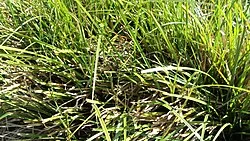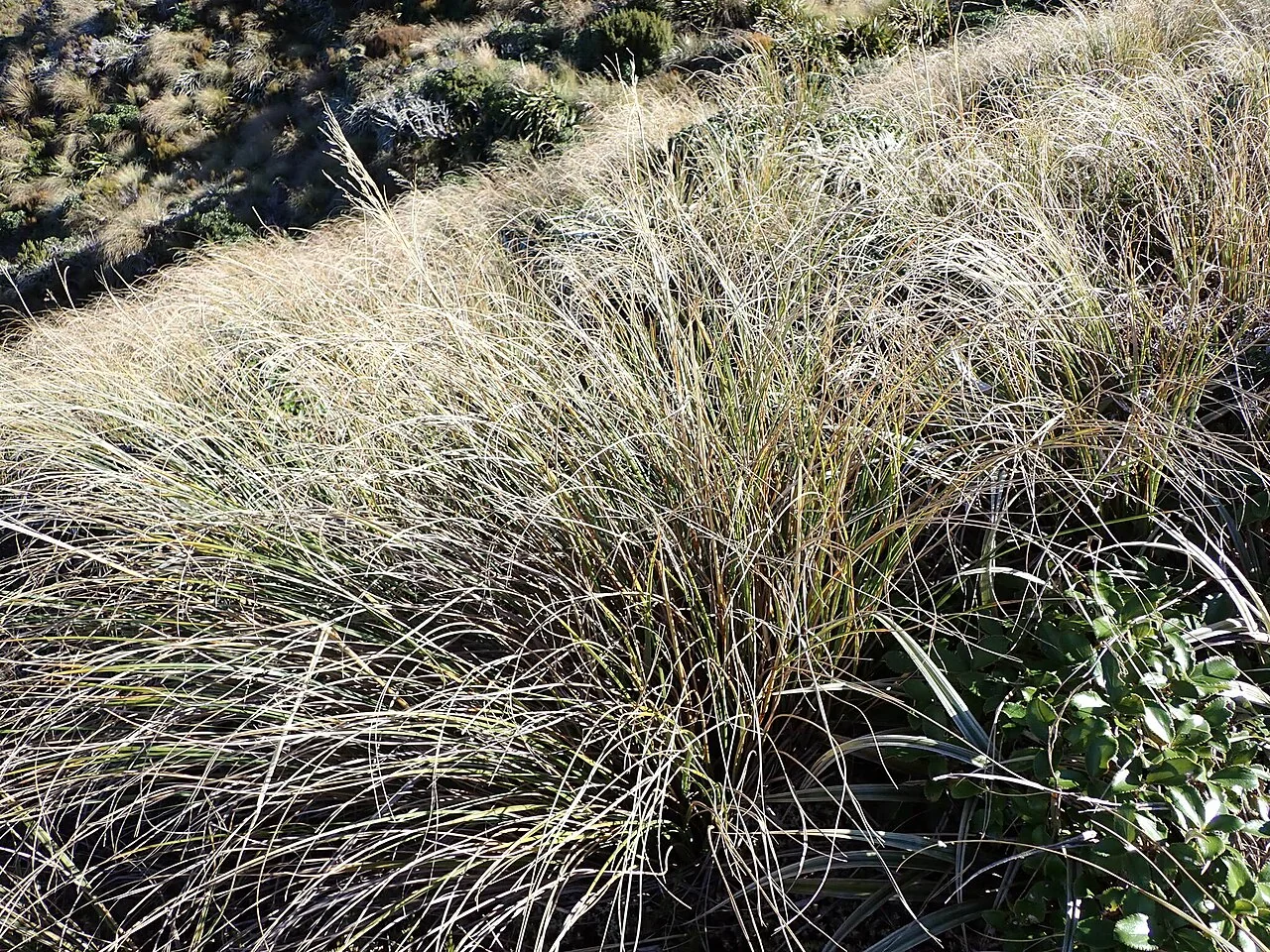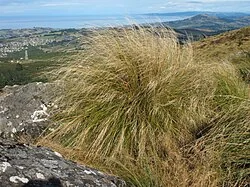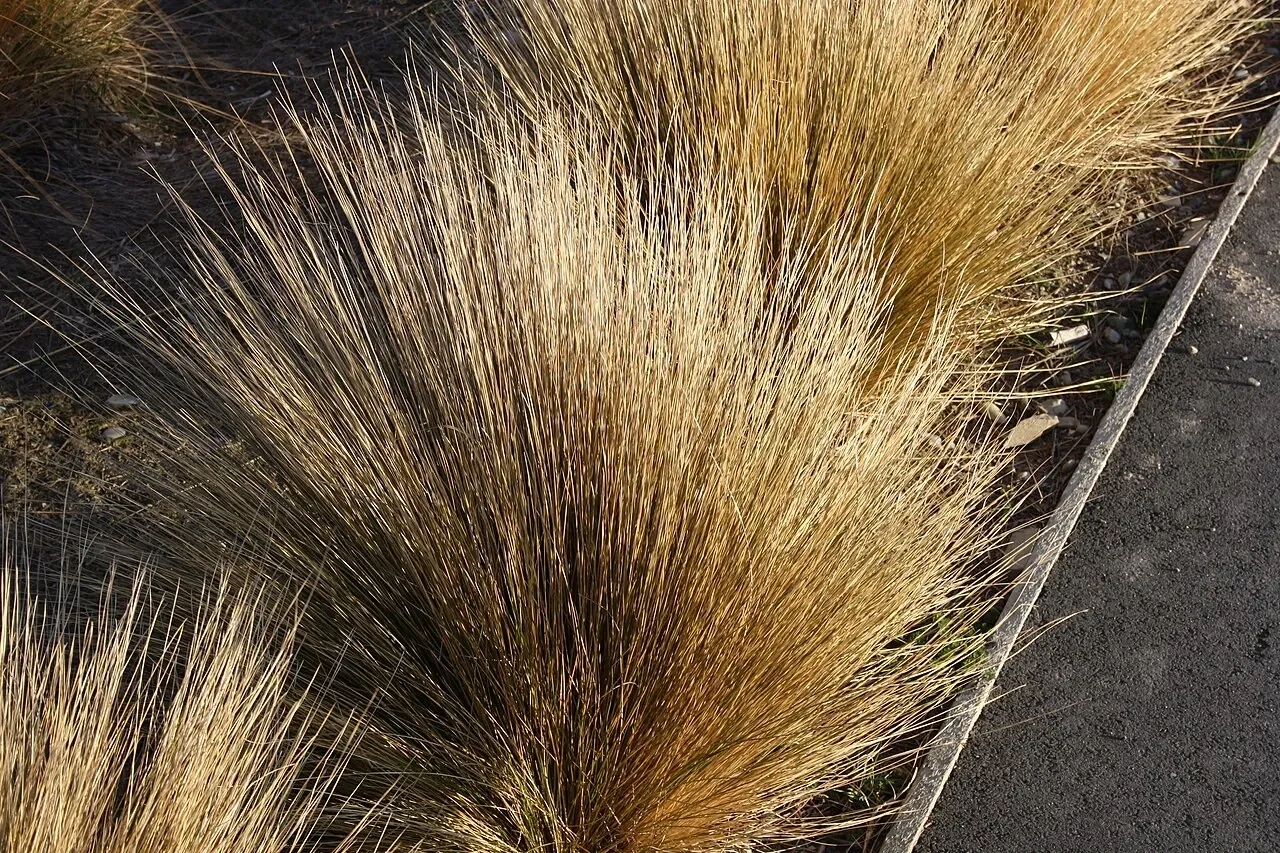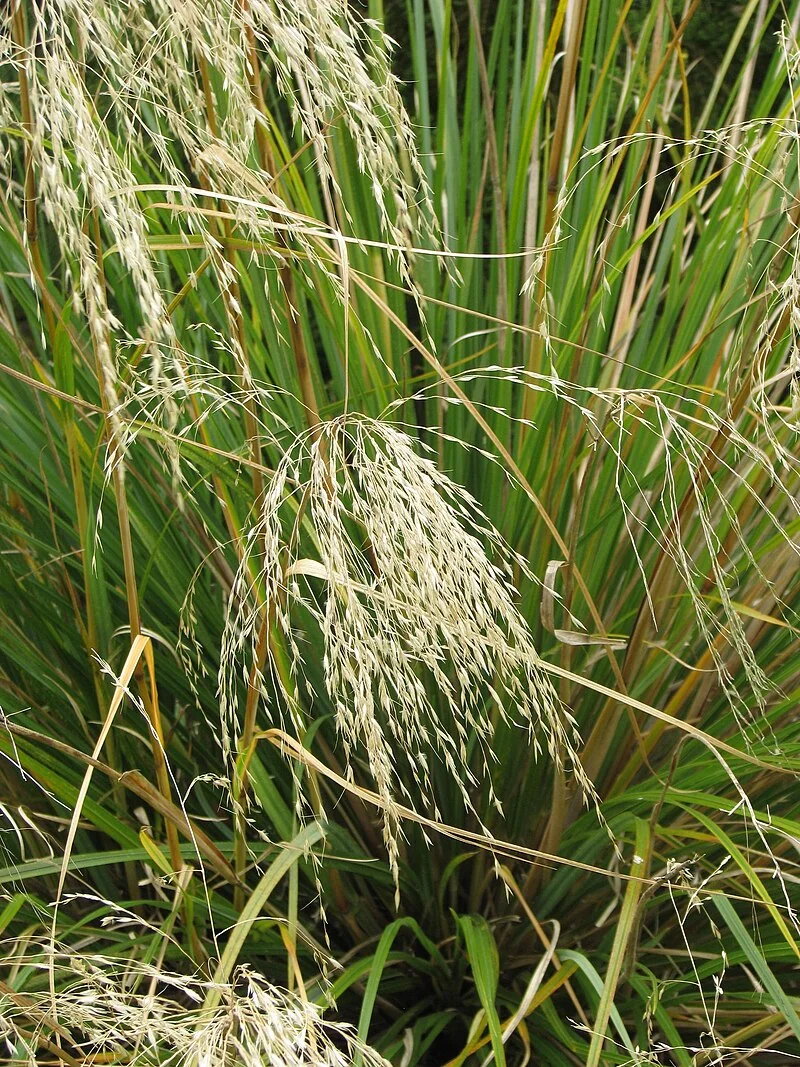
Snow Tussock
Chionochloa conspicua
Chionochloa conspicua , commonly known as Snow Tussock, is a magnificent evergreen perennial grass that stands as one of New Zealand's most spectacular native tussocks. This architectural giant forms impressive clumps up to 2.5 meters tall when in flower, creating dramatic focal points in both natural landscapes and contemporary gardens. The plant's distinctive fountain-like growth habit features arching, narrow leaves in blue-green to olive tones, crowned by towering plumes of feathery, golden-tan flowers that dance gracefully in mountain breezes. Native to the subalpine and alpine zones of New Zealand's South Island mountains, this hardy species demonstrates remarkable resilience to harsh weather conditions while providing year-round structural beauty and movement in garden settings.

Plant Description
Chionochloa conspicua is a large tussock grass with arching, hair-fine leaves and tall, nodding flower panicles that move beautifully in wind. A signature grass of coastal and lowland hills in the east.
Quick Facts
| Scientific Name | Chionochloa Conspicua |
|---|---|
| Common Name | Snow Tussock, Tall Tussock, Plumed Tussock, Conspicuous Chionochloa, Conspicuous Spear Grass |
| Plant Type | Evergreen perennial grass |
| Height | 75-120 cm (2.5-4 ft) for foliage, up to 2.5 meters for flower spikes |
| Spread | 30-60 cm (1-2 ft) |
| Growth Habit | Large, dense, graceful arching clumps with a tufted, fountain-like habit |
| Foliage | Narrow, linear, green to bluish-green (sometimes tinged red-brown), evergreen |
| Flowers | Tall, elegant flowering stems with huge, feathery plumes of silvery-white or tan flowers (late winter to spring, or summer and fall) |
| Hardiness | Hardy, tolerant of frost, wind, extended dry periods (once established) |
| Light | Full sun to partial shade |
| Soil | Moist but well-drained, light, fertile soil; tolerates almost any soil type (poor, sandy, rocky) |
| Resistance | Deer, verticillium wilt |
| Uses | Native and coastal garden designs, mass plantings, ornamental grass borders, feature plant, erosion control, slope stabilization, habitat restoration, wetland revegetation, around water features |
| Family | Poaceae (Grass family) |
| Conservation Status | Not Threatened |
| Distribution | South Island mountains (Canterbury, Otago, Southland) |
| Habitat | Subalpine and alpine grasslands, tussock lands |
| Flowering Time | Late winter to spring, summer to fall |
| Growth Rate | Moderate |
| Lifespan | Long-lived perennial (20+ years) |
| Water Needs | Low to moderate - drought tolerant |
| Wind Tolerance | Excellent |
| Frost Tolerance | Very hardy - tolerates severe frosts |
| Salt Tolerance | Moderate |
| Maintenance | Low |
| Propagation | Division, seed |
Climate Best Suited to
Temperate, windy sites; tolerates drought and light frost; prefers free-draining slopes.
Regional Suitability
| City | Climate Suitability |
|---|---|
| Whangārei | Ideal |
| Auckland | Ideal |
| Hamilton | Ideal |
| Tauranga | Ideal |
| Rotorua | Ideal |
| Gisborne | Ideal |
| New Plymouth | Ideal |
| Napier | Ideal |
| Whanganui | Ideal |
| Palmerston North | Ideal |
| Wellington | Ideal |
| Nelson | Ideal |
| Christchurch | Ideal |
| Dunedin | Ideal |
| Invercargill | Ideal |
Natural Habitat
Windy coastal hills, river terraces and dry, open slopes, especially in eastern districts. Prefers lean, stony, free‑draining soils where winter water does not linger and shrub competition is sparse.
Plant Conservation
Not Threatened overall but locally reduced where grasslands were converted or rabbits and hares browse new growth. Weed control and careful grazing regimes maintain healthy, self‑regenerating stands.
How to Grow
Planting Guide
Best Planting Practices
Plant on slopes or raised beds and keep crowns slightly elevated. Space 1-1.5 m to showcase mature mounds. Backfill with gritty soil, water to settle, and avoid rich fertiliser which encourages lax growth.
Ecology
In South Island tussocklands, established clumps slow runoff and trap wind-blown litter, steadily building thin soils. The dense skirts provide shelter and basking edges for endemic skinks and invertebrates, while tall plumes contribute seeds and structure for insects and small birds.
Uses
Signature feature for movement and light; anchor species for large, naturalistic drifts and restored coastal grasslands. Effective as a tall screen that retains transparency.
Landscaping Ideas
Combine with Olearia , Coprosma and divaricating shrubs for east‑coast schemes, or contrast with low Hebe and silver Chionochloa flavicans for tonal planting.
Seasonal Care
Late Winter
Comb out thatch in late winter; avoid hard shearing which can disfigure. Deep soak during prolonged drought on very light soils, then allow to dry again.
Pruning
Pruning Techniques
Avoid shearing. Each late winter, comb out dead leaves by hand and cut old flower stalks at the base. Division of very old clumps is seldom needed and recovery can be slow; prioritise drainage and space over heavy maintenance.
How to Grow Snow Tussock
Snow Tussock thrives in full sun, exposure and free-draining, often sandy or rocky soils. Prepare wide planting holes, avoid rich fertiliser, and water to settle while keeping the crown slightly elevated so water does not pool. Space plants generously to showcase the mature fountain of foliage and allow wind movement. In dry climates, a deep soak during the first summer hastens establishment; thereafter, plants are drought tolerant.
Seed
Snow Tussock produces abundant seeds in autumn from its spectacular plumed flower heads. Collect fresh seed when the large, divided golden sprays begin to break apart and seeds are easily shaken from the panicles. Sow immediately on a lean, free-draining seed-raising mix, barely covering with fine grit to maintain moisture while preventing fungal issues. Keep consistently moist at around 15°C (60°F), providing bright light but protection from direct sun. While seeds germinate without pre-treatment, cold stratification for 4 weeks significantly speeds up and evens out germination timing. Seedlings emerge slowly and initially remain quite small, requiring patient care during their first year. Pot individual seedlings on to a gritty, well-draining mix once they develop a small root system, or grow multiple seedlings in clumps for faster establishment of larger specimen plants. Harden off gradually before transplanting to permanent positions on raised beds or slopes with excellent drainage.
Division
Large, healthy clumps can be divided cautiously in early spring. Slice with a sharp spade into sections with a strong core; replant into lean, stony soil, water thoroughly, and stake lightly until rooted. Division refreshes over-crowded clumps and supplies planting stock.
After-Care
Comb out thatch in late winter; avoid hard shearing that disfigures the tussock. Maintain excellent drainage, especially over winter, and resist over-feeding to preserve tight habit and longevity.
Pests and Diseases
Common Problems and Solutions
Generally resilient. Waterlogged sites cause crown rot and premature dieback; heavy, fertile soils produce lax growth prone to lodging. Rabbits or hares may nibble soft new leaves. Leaf spots are uncommon and usually cosmetic in open, windy positions.
Cultural Significance
Traditional Uses and Values
Tussock grasslands are emblematic of Te Waipounamu high-country landscapes, shaping regional identity and pastoral history. Snow tussock features widely in restoration and public plantings, celebrating the wind, light and movement of eastern South Island environments.
Bonus Tip
Expert Growing Advice
For maximum plume drama, plant on a slight mound where afternoon sun backlights the inflorescences and breezes can pass freely. Give each plant ample space so the arching leaves form a full skirt without snagging neighbouring shrubs.

